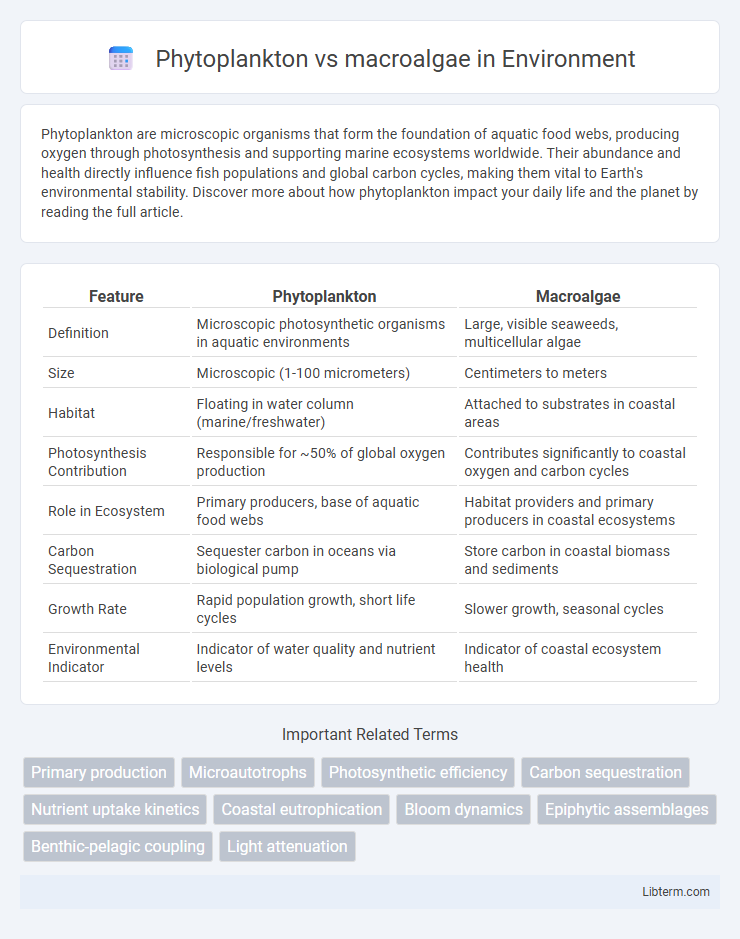Phytoplankton are microscopic organisms that form the foundation of aquatic food webs, producing oxygen through photosynthesis and supporting marine ecosystems worldwide. Their abundance and health directly influence fish populations and global carbon cycles, making them vital to Earth's environmental stability. Discover more about how phytoplankton impact your daily life and the planet by reading the full article.
Table of Comparison
| Feature | Phytoplankton | Macroalgae |
|---|---|---|
| Definition | Microscopic photosynthetic organisms in aquatic environments | Large, visible seaweeds, multicellular algae |
| Size | Microscopic (1-100 micrometers) | Centimeters to meters |
| Habitat | Floating in water column (marine/freshwater) | Attached to substrates in coastal areas |
| Photosynthesis Contribution | Responsible for ~50% of global oxygen production | Contributes significantly to coastal oxygen and carbon cycles |
| Role in Ecosystem | Primary producers, base of aquatic food webs | Habitat providers and primary producers in coastal ecosystems |
| Carbon Sequestration | Sequester carbon in oceans via biological pump | Store carbon in coastal biomass and sediments |
| Growth Rate | Rapid population growth, short life cycles | Slower growth, seasonal cycles |
| Environmental Indicator | Indicator of water quality and nutrient levels | Indicator of coastal ecosystem health |
Introduction to Phytoplankton and Macroalgae
Phytoplankton are microscopic, photosynthetic organisms that form the foundation of aquatic food webs and contribute significantly to global oxygen production. Macroalgae, commonly known as seaweeds, are larger, multicellular algae that thrive in coastal environments and serve as important habitats and nutrients for marine species. Both phytoplankton and macroalgae play crucial roles in carbon fixation and maintaining marine ecosystem health.
Key Differences Between Phytoplankton and Macroalgae
Phytoplankton are microscopic, single-celled organisms that drift freely in aquatic environments, playing a crucial role in global oxygen production and carbon cycling. Macroalgae, commonly known as seaweeds, are multicellular, larger organisms attached to substrates in marine or freshwater ecosystems, serving as important habitats and food sources for marine life. Unlike phytoplankton, which rely primarily on photosynthesis in the photic zone, macroalgae exhibit diverse structural adaptations for survival in various intertidal and subtidal zones.
Taxonomy and Classification
Phytoplankton belong primarily to various classes of microscopic algae and cyanobacteria within the domain Eukarya and Bacteria, including divisions such as Bacillariophyta (diatoms) and Chlorophyta (green algae). Macroalgae, commonly known as seaweeds, fall into three main groups based on pigmentation and taxonomy: Rhodophyta (red algae), Phaeophyceae (brown algae), and Chlorophyta (green algae). While both contribute to aquatic ecosystems, phytoplankton are predominantly unicellular and planktonic, whereas macroalgae are multicellular and benthic, classified accordingly in taxonomic hierarchies.
Habitat and Environmental Niches
Phytoplankton primarily inhabit the euphotic zone of open oceans and freshwater bodies, thriving in nutrient-rich, well-lit surface waters where they perform photosynthesis. Macroalgae are predominantly found in coastal and intertidal zones, attaching to substrates such as rocks and coral reefs, adapting to varying light, salinity, and wave exposure. These environmental niches highlight phytoplankton's role in pelagic ecosystems and macroalgae's importance in benthic communities, each supporting distinct marine food webs and biogeochemical cycles.
Morphology and Structure Comparisons
Phytoplankton are microscopic, single-celled organisms with simple structures such as silica or calcium carbonate shells, enabling buoyancy and efficient light absorption for photosynthesis. In contrast, macroalgae are multicellular, often large and complex with differentiated tissues like blades, stipes, and holdfasts that provide structural support and anchorage. The morphological complexity of macroalgae allows them to occupy various marine habitats, whereas phytoplankton's simple morphology suits the pelagic, free-floating environment.
Photosynthetic Efficiency and Light Utilization
Phytoplankton exhibit higher photosynthetic efficiency due to their smaller size and greater surface area-to-volume ratio, allowing rapid light absorption even under low-light conditions. Macroalgae utilize different pigments to capture a broader spectrum of light but often face self-shading, reducing overall light utilization efficiency. The dynamic light environment in aquatic ecosystems favors phytoplankton for efficient light harvesting, whereas macroalgae optimize energy capture through structural adaptations and pigment diversity.
Role in Aquatic Ecosystems
Phytoplankton serve as the foundational primary producers in aquatic ecosystems, driving global carbon cycling through photosynthesis and supporting marine food webs by supplying essential nutrients to zooplankton and fish. Macroalgae, such as kelp and seaweed, provide critical habitat structures, enhance biodiversity, and contribute to coastal protection by stabilizing sediments and buffering shorelines from wave action. Both groups are vital for oxygen production and nutrient cycling, but phytoplankton dominate pelagic zones while macroalgae primarily influence benthic environments.
Contribution to Global Carbon Cycle
Phytoplankton contribute approximately 50% of global primary production, playing a crucial role in sequestering carbon dioxide through photosynthesis in oceanic ecosystems. Macroalgae, although covering less surface area, significantly impact coastal carbon cycling by capturing carbon and exporting organic matter to deep ocean sediments. Both groups are vital for mitigating climate change, with phytoplankton driving open-ocean carbon fixation and macroalgae enhancing carbon storage in coastal zones.
Ecological Importance and Applications
Phytoplankton contribute significantly to global oxygen production and serve as the foundational primary producers in aquatic food webs, supporting marine biodiversity. Macroalgae, or seaweeds, provide critical habitats and food sources for various marine organisms while playing a vital role in nutrient cycling and carbon sequestration in coastal ecosystems. Both groups have applications in biotechnology, including biofuel production, pharmaceuticals, and sustainable agriculture, highlighting their ecological and economic importance.
Challenges and Future Research Directions
Phytoplankton and macroalgae face significant challenges such as environmental stressors, nutrient limitations, and climate change impacts that affect their growth and ecological roles. Future research directions emphasize understanding their adaptive mechanisms, improving cultivation techniques for biofuel and bioproducts, and enhancing carbon sequestration potential through genetic and biotechnological advancements. Investigating interactions with microbial communities and developing sustainable harvesting methods are critical for ecosystem management and resource optimization.
Phytoplankton Infographic

 libterm.com
libterm.com